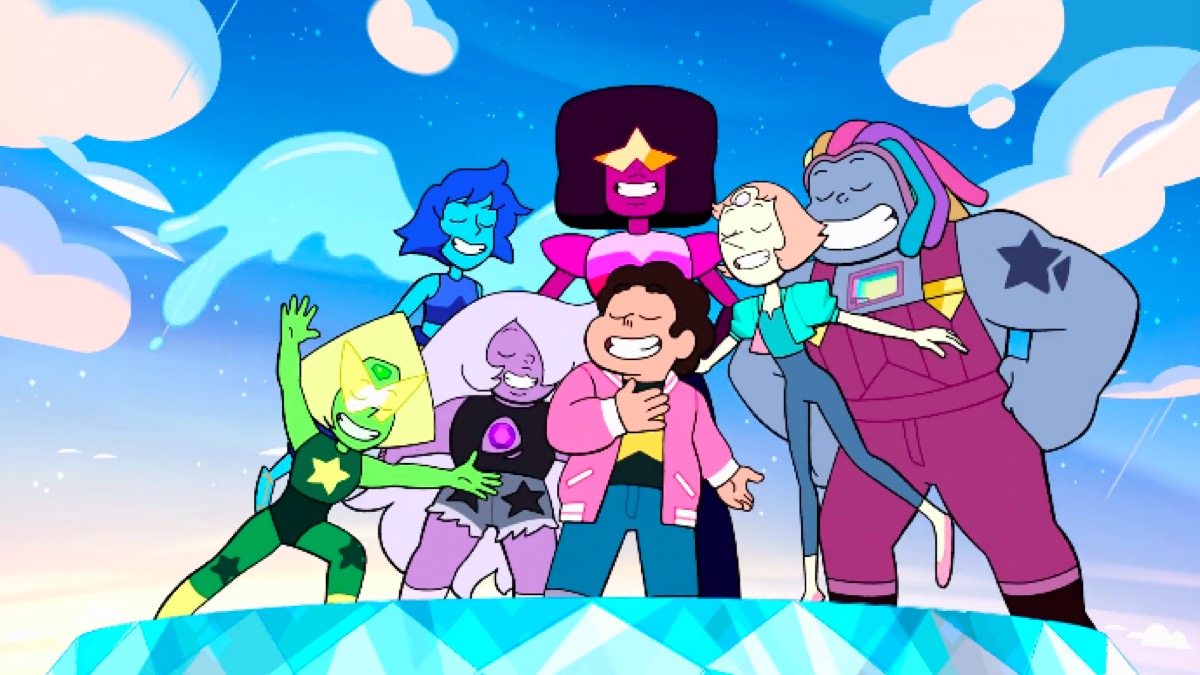Cartoon Network Tried to Downplay The Queerness of Steven Universe
A new interview with creator Rebecca Sugar goes behind the scenes of the award-winning series.

Few shows have changed the landscape of animation like Steven Universe has. The series, which premiered on Cartoon Network in 2013, followed the adventures of young boy Steven Universe, who lives with Garnet, Amethyst, and Pearl, magical aliens known as the Crystal Gems. Created by Adventure Time alum Rebecca Sugar, the series quickly drew raves for its expansive and compassionate portrayal of LGBTQ+ characters and gender fluidity. Steven Universe was the first animated series to win the GLAAD Media Award for Outstanding Kids & Family Program in 2019, and took home a Peabody Award the same year.
But while the series reaped critical acclaim and a devoted queer fanbase, Sugar describes a very different attitude from Cartoon Network behind the scenes. In a joint interview with She-Ra and the Princesses of Power showrunner Noelle Stevenson for Paper Magazine, Sugar described the pushback she received from the network.
Sugar said, “We strategized the concept of fusion to be able to explore relationships and include queer relationships. Central to that, one of the things we were excited about was to have the character of Garnet have a ton of screen time and be a main character.” In season 2 episode “The Answer”, the series revealed that Garnet was a fusion of two queer gems, Ruby and Sapphire. According to Sugar, the network was less than supportive.
“They told us point-blank, ‘you can’t have these characters be in a romantic relationship,’ but at that point Garnet was so established that audiences could instantly understand what the relationship was, the song had already been written, the episode had already been boarded so we were already in full production. I’m really proud of the patience we had and the time that we took to fully explore these characters at a time when that was not necessarily possible.
Back in 2014, 2015, 2016 I was told that I couldn’t discuss it publicly. They basically brought me in and said ‘we want to support that you’re doing this but you have to understand that internationally if you speak about this publicly, the show will be pulled from a lot of countries and that may mean the end of the show.’ They actually gave me the choice to speak about it or not, to tell the truth about it or not, around 2015/ 2016, by then I was honestly really mentally ill and I dissociated at Comic Con.
I would privately do drawings of these characters kissing and hugging that I was not allowed to share. I couldn’t reconcile how simple this felt to me and how impossible it was to do, so I talked about it. The show survived in a large part because of the support from fans. I’m really proud of the choice we made and what we were able to accomplish together. I’m so proud of my team who supported me through all of this, crafted the show and navigated this with me.
The way they put their mental health on the line to tell stories that were personal to them. It seems absurd to think that only a few years ago and really now, that a person’s job, their ability to make cartoons, could hinge on their sexual orientation, it’s profoundly unfair and ridiculous but true. That really needs to shift and is still in the process of shifting. I only understand what I saw from inside the framework of Cartoon Network and Turner, so Noelle, if you’d like to speak about this I completely respect and understand the difficulty of talking about going through something like this so definitely only share what makes you comfortable.”
Stevenson said she faced similar pushback from Netflix, even after She-Ra premiered in a post-Steven Universe world. She described support waning after the 2016 election saying, “At first it seemed like we were going to get this from the company, we were really excited about that and so we were setting things up in season one, we had the “Princess Prom” episode, then the election in 2016 happened and everybody got really scared. It was immediately, like Rebecca said, the same kind of pushback where we were told point-blank we would not be able to do this. Across the board, no romance. That was how broad it got! Let’s just be extra-safe, no romance whatsoever.”
Both series, which still boast a massive fan base, are proof that queer stories have a massive fan base, not just in animation, but across pop culture. The interview is a fascinating look at the creative process for both shows, and the determination of queer creators to make sure they get to tell their own stories.
(via Paper Magazine, image: Cartoon Network)
Want more stories like this? Become a subscriber and support the site!
—The Mary Sue has a strict comment policy that forbids, but is not limited to, personal insults toward anyone, hate speech, and trolling.—
Have a tip we should know? tips@themarysue.com